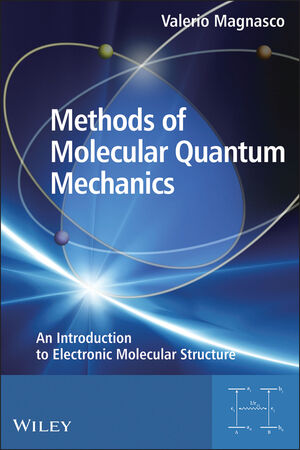Methods of Molecular Quantum Mechanics: An Introduction to Electronic Molecular StructureISBN: 978-0-470-68441-2
Paperback
304 pages
December 2009
 Other Available Formats: Hardcover
|
||||||
1. Principles.
1.1 The Orbital Model.
1.2 Mathematical Methods.
1.3 Basic Postulates.
1.4 Physical Interpretation of the Basic Principles.
2. Matrices.
2.1 Definitions and Elementary Properties.
2.2 Properties of Determinants.
2.3 Special Matrices.
2.4 The Matrix Eigenvalue Problem.
3. Atomic Orbitals.
3.1 Atomic Orbitals as a Basis for Molecular Calculations.
3.2 Hydrogen-like Atomic Orbitals.
3.3 Slater-type Orbitals.
3.4 Gaussian-type Orbitals.
4. The Variation Method.
4.1 Variation Principles.
4.2 Nonlinear Parameters.
4.3 Linear Parameters and the Ritz Method.
4.4 Applications of the Ritz Method.
5. Spin.
5.1 The Zeeman Effect.
5.2 The Pauli Equations for One-electron Spin.
5.3 The Dirac Formula for N-electron Spin.
6. Antisymmetry of Many-electron Wavefunctions.
6.1 Antisymmetry Requirement and the Pauli Principle.
6.2 Slater Determinants.
6.3 Distributions Functions.
6.4 Average Values of Operators.
7. Self-consistent-field Calculations and Model Hamiltonians.
7.1 Elements of Hartree-Fock Theory for Closed Shells.
7.2 Roothaan Formulation of the LCAO-MO-SCF Equations.
7.3 Molecular Self-consistent-field Calculations.
7.4 Hückel Theory.
7.5 A Model for the One-dimensional Crystal.
8. Post-Hartree-Fock Methods.
8.1 Configuration Interaction.
8.2 Multiconfiguration Self-consistent-field.
8.3 Møller-Plesset Theory.
8.4 The MP2-R12 Method.
8.5 The CC-R12 Method.
8.6 Density Functional Theory.
9. Valence Bond Theory and the Chemical Bond.
9.1 The Born-Oppenheimer Approximation.
9.2 The Hydrogen Molecule H<sub>2</sub>.
9.3 The Origin of the Chemical Bond.
9.4 Valence Bond Theory and the Chemical Bond.
9.5 Hybridization and Molecular Structure.
9.6 Pauling’s Formula for Conjugated and Aromatic Hydrocarbons.
10. Elements of Rayleigh-Schroedinger Perturbation Theory.
10.1 Rayleigh-Schroedinger Perturbation Equations.
10.2 First-order Theory.
10.3 Second-order Theory.
10.4 Approximate E<sub>2</subZ> Calculations: The Hylleraas Functional.
10.5 Linear Pseudostates and Molecular Properties.
10.6 Quantum Theory of Magnetic Susceptibilities.
11. Atomic and Molecular Interactions.
11.1 The H-H Nonexpanded Interactions up to Second Order.
11.2 The H-H Expanded Interactions up to Second Order.
11.3 Molecular Interactions.
11.4 Van der Waals and Hydrogen Bonds.
11.5 The Keesom Interaction.
12. Symmetry.
12.1 Molecular Symmetry.
12.2 Group Theoretical Methods.
12.3 Illustrative Examples.
References.
Author Index.
Subject Index.



